Content
- 1 Correct selection of varieties
- 2 Seed preparation
- 3 Place for beds
- 4 Sowing
- 5 How to care for the beds
- 6 Types and varieties of carrots
- 7 Carrots: growing features
- 8 Sowing with seeds in open ground
- 9 Carrots: outdoor care and proper watering
- 10 Harvesting and storage of crops
- 11 The nuances of growing in the Moscow region, in Siberia
- 12 Dates of planting carrots in the Moscow region
- 13 The best varieties
- 14 Carrot sowing process
- 15 Care features
- 16 Conclusion
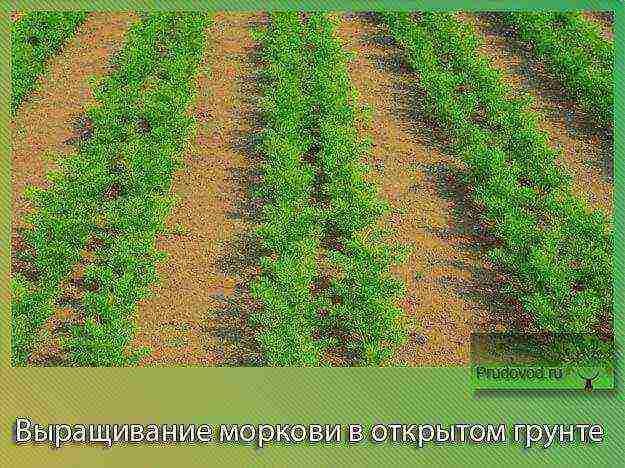
Hello dear blog readers.
After potatoes, carrots are without a doubt the most popular vegetable. Almost everyone who has a piece of land is trying to grow it. Only the yield, the quality of the fruit is not always pleasing. Meanwhile, growing carrots outdoors is not difficult. If you know all the secrets, you can get a good harvest even on poor soil.
Correct selection of varieties
It has been verified by practice which varieties of carrots have the best yield in the conditions of the Moscow region. These include:
- Callisto is a hybrid of mid-season dates, perfectly preserved. The disadvantage is poor resistance to drying out of the soil;
- Shantane is an excellent mid-season carrot;
- The queen of autumn is a mid-late period carrot that ripens amicably. Resistant to frost, root crops do not burst. Suitable for sowing in autumn and spring;
- Incomparable - a very sweet mid-season variety with a high content of carotene;
- Vitamin 6 - medium early carrots, well stored.
Of course, you can choose other varieties, but these have the highest yield. Look at the photos that will also help you make the right choice.

Seed preparation
The seeds have an oily shell that makes them difficult to germinate. For seedlings to appear early and amicably, pre-sowing processing technology is used. Of all the methods, choose the one you like:
- The seeds are placed in cloth bags, soaked in warm water for a day, changing it from time to time. Soaking in ash infusion will be more effective: 1 spoon per liter of water.
- After the previous procedure, rinse, place the seeds in the refrigerator for up to 5 days, the seedlings will be even better.
- Soak in hot 50-degree water for 20 minutes, then hold in cold for 2 minutes.
- Dry seeds in fabric bags are buried in the soil, kept under cold ground for 10 days.
- The seeds are mixed with moistened peat and kept warm until sprouts 0.5 cm long hatch.
Use last year's seeds that have the highest germination capacity.
After preparation, the seeds are slightly dried, they are ready for sowing. Choose one of the methods, apply it, the yield will only increase from this.
Place for beds
Carrots have their own specific requirements for the site where they will grow. They are not complicated:
- it should be in a sunny place, carrots do not tolerate even slight shading;
- on soil with a light structure, beautiful root crops grow without deformations;
- the beds are placed in a place with good drainage, where water accumulation is impossible.

The most suitable are sandy loam and light loamy soils with low acidity. The beds begin to be prepared in the fall. All impurities such as stones, roots, which will interfere with the normal formation of root crops, are removed from the soil. The structure is improved by adding peat, river sand, sawdust. Flammability is increased by introducing compost or humus: up to 10 kg per 1 m2. Acidic soils are lime.
Never apply fresh manure and nitrogen fertilizers: the plants will bloom and the roots will branch out.
In the spring, the beds are shallowly dug up, lumps of earth are broken with a rake, the surface is leveled. It is good to cover the area under the carrots with a film, under which the soil warms up better, and the soil does not dry out.
Sowing
First, let's talk about the timing: carrots can be sown in autumn, early spring and later. It all depends on the purpose of cultivation, variety. Podzimny sowing allows you to get very early production. Under the snow, the seeds undergo vernalization and start growing with the first warmth. Cold resistance of carrots ensures germination at 5-6 °. Such root vegetables are suitable only for fresh consumption, they cannot be stored.
Carrots sown in early spring are also poorly preserved, they are used fresh and for conservation. To have useful roots throughout the winter, they are sown later, starting from mid-April to June. The time is chosen depending on the weather: the land should be humid, the temperature is moderate.
Sowing seeds through a small size is difficult, so different technologies are used:
- mixed with sand, then sown;
- planted together with radishes, which emerge earlier and indicate the rows;
- the seeds are glued onto strips of toilet paper, laid in furrows.
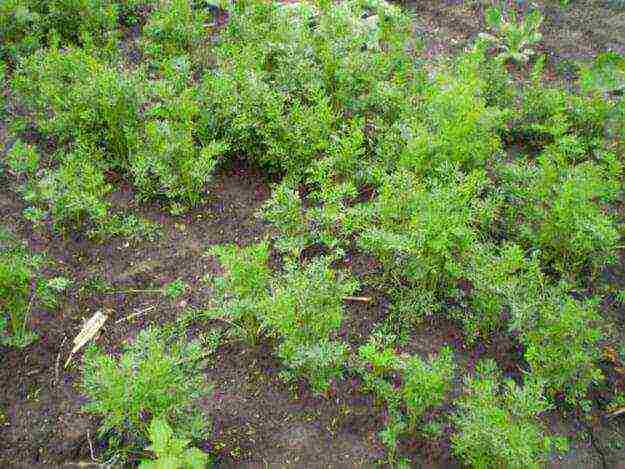
On the prepared land, cut small furrows every 15-20 cm, well watered. The soil is powdered with ash, seeds are thrown and covered with soil, mulched with humus or peat 5 cm thick.
The soil on the rows must be compacted with a roller or board.
Seeds start to grow at three degrees of heat. Young bushes are able to withstand small frosts, they die when the temperature is higher for a long time - 6 °. A mature plant can withstand colder temperatures.
How to care for the beds
Carrot care includes:
- watering;
- weeding;
- top dressing;
- thinning of seedlings.
The frequency of watering is influenced by the age of the plants, weather conditions. Caring for this crop requires careful attention to soil moisture: lack of moisture and its excessive amount are harmful. Waterlogging is especially unpleasant, even for a short time: it causes decay of root crops. Drought slows down the development of plants.
Weeding is carried out with the appearance of the first true leaf. It is combined with thinning. Seedlings are usually very thickened, since small seeds are difficult to sow at regular intervals. Weeding and thinning are carried out after rain or watering.
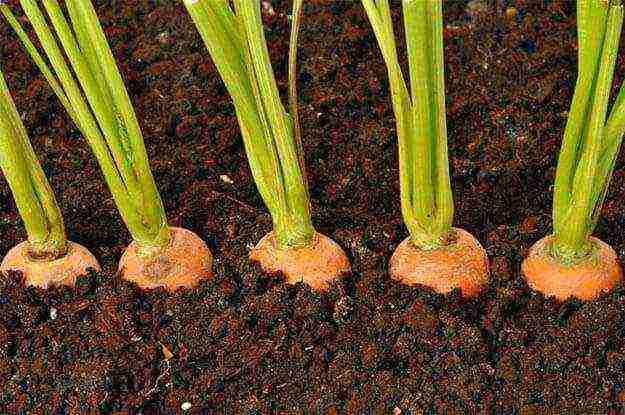
The technology requires the removal of unnecessary plants. At the first thinning, shoots are left after about 3 cm. When the second pair of leaves is formed, thinning with weeding is repeated. This time, plants should remain after 6 cm, no less. Now the weaker ones are removed, they are not loosened, but pulled up from the moist soil.
Do not leave more roots than necessary, otherwise the roots will grow small.
Weeding is used to control weeds. So that a crust does not form on the surface of the soil, the soil is loosened after irrigation and rain. Hilling carrots will prevent greening of the top of the roots protruding above the ground.
Carrots are fed twice with potash fertilizers: after the first and second thinning. First, use two spoons per 10 liters of water, in the second - three.
Half a kilogram of wood ash per square meter improves the taste and its preservation.
The correct technology of sowing and carrots care allows you to get an excellent harvest.
Please share with your friends the link to the article. Until next time.
At each summer cottage, at least one garden bed is allocated for carrots. This root vegetable is highly respected by housewives. But the trouble is, often instead of a juicy, bright and large harvest, summer residents collect thin, weak and unhappy root crops. There may be several reasons for this failure. This is an incorrectly selected area, an error in the selection of a variety, and a violation of the temperature regime. If you are interested in the correct selection of carrot varieties for the Moscow region, then we can share useful information.
Carrots Vitamin 6 ripens in 3 months
The scientific name of the culture that we happily gnaw in the kitchen is sowing carrots. It grows well in all regions. A distinctive feature of the Moscow region is marginal soils. But even in such conditions, you can get a high yield of carrots if you choose the appropriate variety. The best varieties for this area are:
- "Vitamin 6". Medium early carrots bred in 1969. It takes about 90 days from planting to eating root crops. A crop with a very high yield, and the possibility of long storage.
- "Moscow winter". A mid-season variety. Suitable for growing in the spring and for planting in the winter.
- Callisto. Large mid-season hybrid. Well suited for long-term transportation and winter storage. The variety is weakly resistant to drought, requires adherence to the irrigation regime.
- "Shantane". Mid-ripening carrots, the ripening time of which for the Moscow region ranges from 70 to 120 days. Suitable for outdoor cultivation only.
- "Queen of Autumn". Medium late variety, ripening time - more than 130 days. The root crop has a friendly ripening, has frost resistance, does not burst. Suitable for sowing in spring and planting in autumn.
- "Incomparable". A mid-season root crop. The technical readiness of root crops is 90 days. The variety is prized for its high carotene and sugar content.
If the gardener does not like any of the listed varieties, then he can experiment himself. But these varieties of carrots are actually the best in the conditions of the Moscow region, they give a proven, consistently high yield.
Carrot Incomparable - very sweet variety
Carrots love the beds on which onions, potatoes, cabbage, zucchini, pumpkin or beets grew before it. Areas after green manure are also suitable. Shaded and low-lying areas cannot be selected. The soil for planting should be light, and its preparation is carried out in the fall.
Before freezing, the gardener must carefully dig up the selected area and remove stones and roots. Potash and phosphorus fertilizers are applied to the soil. In the spring, on the eve of planting, the soil is loosened deeply, and a complex of fertilizers is reintroduced. The bed itself should be high enough (at least 20 cm), and the digging depth exceeds 40 cm.
Never plant carrots in the same area for two years in a row! This mistake can destroy even the best varieties. In this case, the root crops get sick and are attacked by pests.
If you plant carrots for the second year in the same place, there will not be a good harvest.
It is very important to know when to start planting different garden crops. Usually, carrot seeds are planted in the open ground in the Moscow region, starting from April 20.Some varieties of seeds are able to germinate at temperatures of 5-6 ° C. But the best conditions are 12-13 ° C.
Carrots can be planted in spring and early summer. But seed germination will be slightly worse, and the roots themselves will be rougher.
The germination capacity of carrot seeds lasts up to three years. Before starting the sowing campaign, the seeds should be sorted and disinfected. The peculiarity of the seed is slow germination. Weeds are able to break through faster and drown out carrot shoots. In order not to damage the beds during weeding, gardeners use several tricky tricks:
- if carrot seeds are mixed in equal proportions with washed and dried sand, then the row will be clearly visible when the time for weeding comes;
- carrot seeds can be mixed with early crops such as lettuce or radish, they sprout quickly, outlining the planting site;
- the seeds are glued in a row with starch paste on narrow bands of toilet paper, the planting strip is clearly visible, and it is not damaged when weeds are removed.
Seed material is laid in open ground in wet furrows, the depth of which is at least 2 cm. From above they are covered with loosened earth or a peat-sand mixture. It is very good when there is an opportunity to immediately cover the beds with foil. In this case, re-watering is not necessary.
Carrot seeds germinate well under the film
Why do you need a film in spring? It retains moisture, protects against insects, prevents the formation of a dense earth crust and raises the temperature of the soil. Together, this creates the best conditions for friendly seedlings. After the sprouts appear, the film can be removed.
Growing carrots involves ruthlessly removing excess plants. It can be difficult for a summer resident to force himself to pull out a blossoming sprout, but this is necessary. The first thinning of the bed is performed when the first pair of true leaves has just opened. As a result of this manipulation, a row of plants should remain at a distance of 3 cm from each other.
After a while, after the formation of the second pair of leaves, the bed is thinned out again. Now weaker shoots are removed, leaving a distance between strong plants of at least 6 cm. Moreover, this must be done as carefully as possible, not loosening the young shoots, but pulling it out of the soil. The manipulation is carried out after evening watering, so as not to attract pests, and to prevent sunburn on injured leaves. If you are late with thinning, or regret it and leave more sprouts in the garden, then the root crops will not be able to gain strength and will be small.
The formation of strong root crops can be prevented by a crust on the surface of the soil. After each watering, the bed must be loosened. Peat mulching of the beds well prevents the formation of a crust.
So that the part of the carrots protruding above the soil does not turn green, they are huddled with some frequency.
Carrots need to be loosened and thinned regularly
Plant growth and development takes about five months. First, the greens develop, and then the root vegetable gains strength. In the first stage, the plant requires abundant and frequent watering. The earth is moistened at the rate of 4 liters of water per linear meter every 2-3 days. The first two months, watering is gradually increased. With the beginning of active growth of root crops, watering is reduced to once a week, 9-10 liters of water per running meter of the garden. If the soil is waterlogged at this time, the carrots may crack.
As the plant grows, top dressing is twice applied to the carrot bed. As the first feeding, weed infusion diluted with water is suitable.
For 1 liter of infusion, 5 liters of water and one spoonful of potash fertilizers are added. This solution is introduced after the first thinning of the shoots. However, many gardeners during sowing add the dust fraction of complex fertilizers, in this case, the first feeding is not necessary.
After the second thinning, the plants are fed again. To do this, add 3 tablespoons of potash fertilizers to a ten-liter bucket of water.
Potash fertilizers - optimal feeding for carrots
The main pests of carrots are umbelliferae and carrot fly. To cope with them, you need to plant the seeds as early as possible, and then cover the beds with lutrasil (non-woven covering material). The carrot fly appears somewhat later than the flea. In parallel with it, a cabbage plant begins to fly over the beds. For this period, the crops should be covered again.
Spores of the fungus can get on the formed root crops, which, when storing the crop, will cause phomosis. This means the carrots will start to rot in storage. To combat this scourge, potash dressings are used.
If the crop is affected by phomosis, then the next time on this site the carrots can be planted no earlier than in 4 years, this is due to the viability of the fungal spores.
Residents of the Moscow region collect and save an excellent harvest of carrots for the winter, since they follow a few simple rules when growing this root crop. Join the army of gardeners and gardeners and let your results be the best among all your neighbors.
l>
Consultation with a doctor on the use of any drugs and procedures posted on the site is required
Carrots, planting and caring for which in the open field require the implementation of certain agrotechnical measures, is a small-seeded crop from the Umbrella family. A native of Afghanistan, where the largest number of root crop species still grows today, came to Europe in the X-XIII centuries.
Types and varieties of carrots
The diversity of the genus is divided into 2 varieties - wild and sowing carrots, used in the agricultural sector. Cultural carrots, in turn, include 2 types of varieties - feed and table varieties.
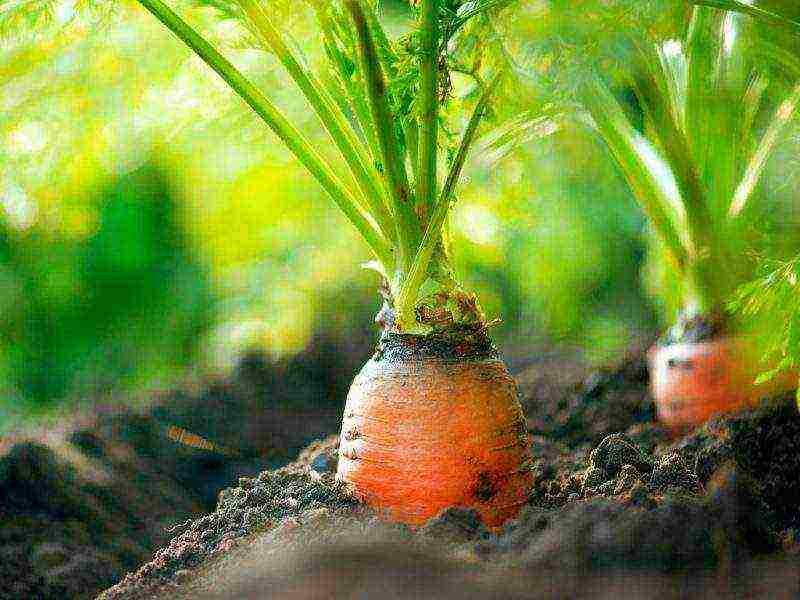
Among the most popular varieties, which breeders are constantly working on, the following stand out:
- "Alyonka" is an early variety with a ripening period of 50 days after germination. Orange roots up to 15 cm long have an average weight of around 145 g.
- "Tushon" is an early ripening variety used for food 60-65 days after germination. The mass of the root crop is 150 g with a length of 20 cm.
- "Nantes" is a mid-season variety, represented by cylindrical blunt-pointed root crops weighing up to 165 g, which are suitable for both food and storage.
- "Vitaminnaya" - a characteristic feature of this mid-ripening root crop is a high concentration of carotene, good taste, and does not crack.
- "Queen of Autumn" is a mid-season variety, the roots of which are excellent for long-term storage.
- "Flakke" is a mid-season variety showing excellent yields even on heavy soil.
- "Mo" is a late-ripening variety with good yields that can be stored throughout the winter. Excellent taste and juiciness.
Carrots: cultivation features
Carrots are not afraid of the cold, but they cannot stand the shade.

When cultivating a representative of the umbrella, it is worth considering the following features:
- evenness of the relief on the site;
- soil composition;
- the depth of digging the beds;
- bright lighting;
- abundant watering;
- compliance with crop rotation;
- timely implementation of protective measures.
Sowing with seeds in open ground
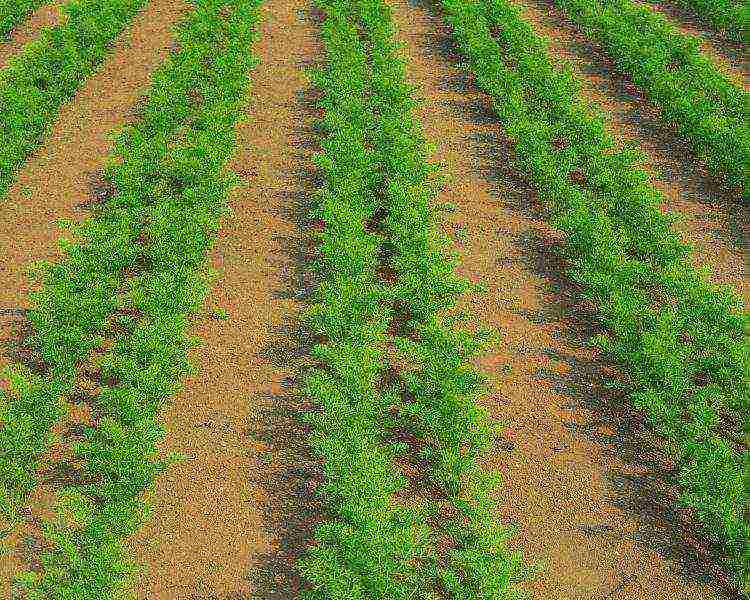
To obtain a good harvest, before proceeding with sowing seeds in garden beds, it is necessary to study the agricultural technology of crop cultivation, starting from the initial stage - sowing.
Site selection and preparation of beds
Carrots show the best harvest performance in flat, well-lit areas, where last year were cultivated nightshade (tomatoes, potatoes), pumpkin (cucumbers, zucchini) crops, as well as garlic, onions and cabbage.If small-seeded crops (dill, fennel, carrots) grew on the site, then you should not stop at it because of the poverty of the soil and the risk of infection with specialized harmful organisms that have accumulated in the soil. The root crop reaches its maximum size on light, loose soils with a good fertile layer.
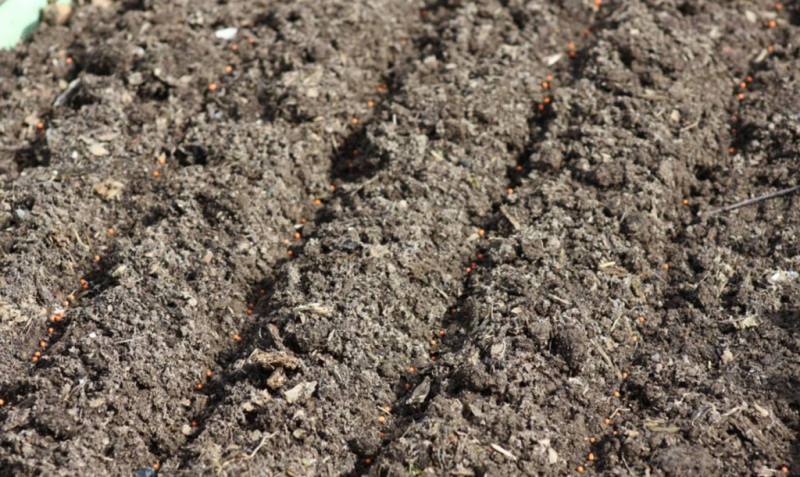
The soil is being prepared for spring sowing in the autumn season:
- The selected area is dug to a depth of 30 cm.
- For digging, fertilizers are applied in the form of 15 g of superphosphate, 15 g of potassium sulfate, 20 g of ammonium nitrate and 2-3 kg of humus per 1 m².
- With the arrival of spring, the site is harrowed with a rake.
Attention! If you dig up only the surface layer of the soil (up to 20 cm), then the root crops will grow crooked, ugly.
How and when to sow?
Carrots are planted in spring in mid-April, when the ground warms up to 4-6 ° C.
However, depending on the characteristics of the site and the selected variety, the timing may fluctuate:
- Mid-season and late varieties are sown from late April to 10 May.
- On light soils, sowing is allowed until the end of the spring season.
- In the southern regions, where the ground warms up earlier, the embedding of seed in open ground can be carried out in the second half of March.
It is known that good seeds are the key to a high yield.
To get healthy seedlings, you must adhere to the following sowing algorithm:
- The seeds are wrapped in cloth and placed in water heated to 50 ° C for 20 minutes, after which they are cooled in cold for several minutes.
- Grooves are prepared with a depth of 2 cm with a distance of 30 cm.
- The distance between the seeds is kept within 2-3 cm.
- After planting the seed, the beds are mulched to prevent crusting.
You can simplify the procedure for preparing seeds: they are buried in a dense tissue in moist cold soil 10 days before sowing.
On a note! Carrots are cold-resistant crops and easily tolerate frosts down to -4 ° C.
Planting carrots in the fall, before winter
Podwinter sowing, which makes it possible to harvest the crop 14 days earlier than usual, is permissible only for early varieties, and is carried out in light soil at the end of October according to the following scheme:
- The soil is prepared 20 days before sowing.
- After sowing, the beds are mulched with a layer of peat 3 cm thick.
- With the arrival of spring, a film is stretched over the site, which is removed when shoots appear.
Carrots: outdoor care and proper watering
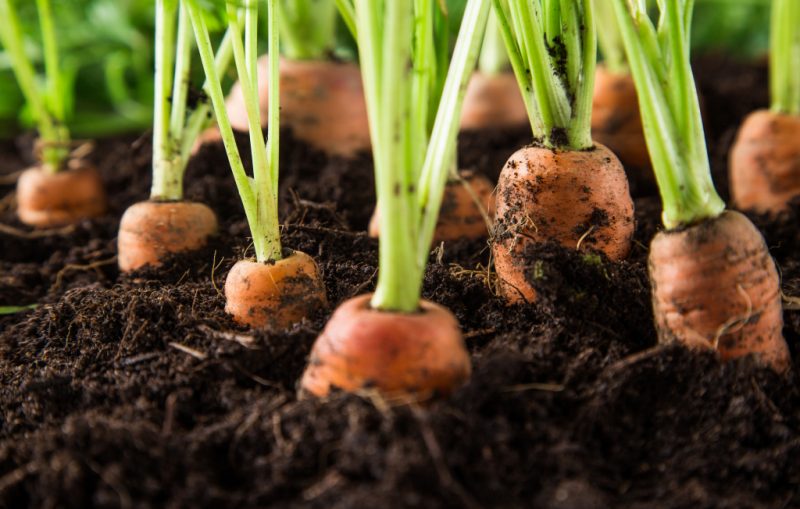
The successful cultivation of a root vegetable rich in vitamins requires the implementation of certain care measures.
Thinning and loosening
With dense sowing, after the formation of one pair of true leaves in the seedlings, thinning is carried out, as a result of which an interval of 2-3 cm should be obtained between the specimens. The second time the crops are thinned out after the formation of two pairs of leaves. The result of the procedure is the distance between the seedlings of 4-6 cm. Together with the thinning, the soil is loosened and cleared of weeds.
Advice! For convenience, it is better to pull through the beds after moistening.
Watering
Timely hydration, which is carried out weekly, is the key to the full development of the plant and the formation of large, juicy root crops.
When watering, in order not to overdo it, but also not to overdry the soil, you should adhere to the recommendations:
- In the first weeks after sowing, the beds are moistened at the rate of 3 liters per 1 m2.
- When the distance between specimens increases to 5 cm, the water consumption increases to 10 liters per 1 m2.
- After the development of dense tops, which indicates the beginning of root growth, the volume of irrigation liquid reaches 20 liters per 1 m2.
- 1.5 months before harvesting, the volume and frequency of moisture is gradually reduced.
Top dressing
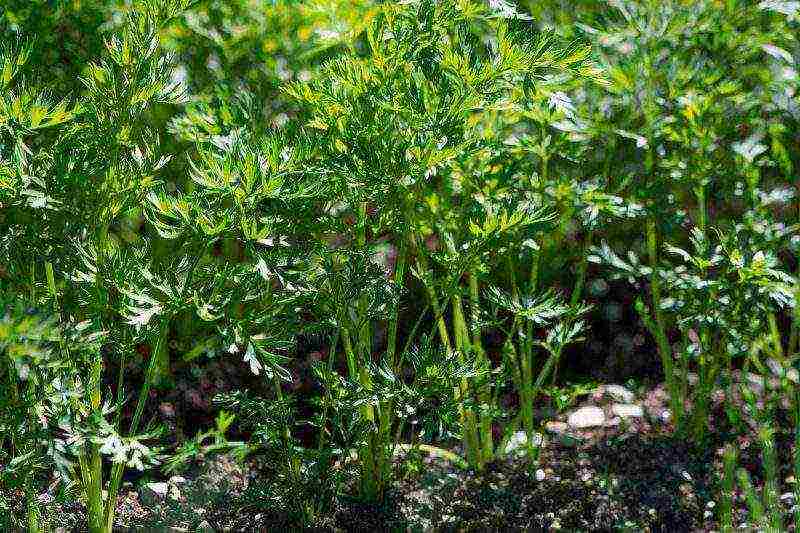
During the growing season, carrots are fed twice (after the second thinning and during the beginning of root growth) using a solution prepared from 400 g of wood ash, 10 g of nitroammophoska, 20 g of potassium nitrate and 15 g of superphosphate per 10 liters of water.
Disease and pest control
Carrots are susceptible to damage by harmful organisms. Among the diseases, the danger is phomosis, bacteriosis, septoria, gray, white, red rot.
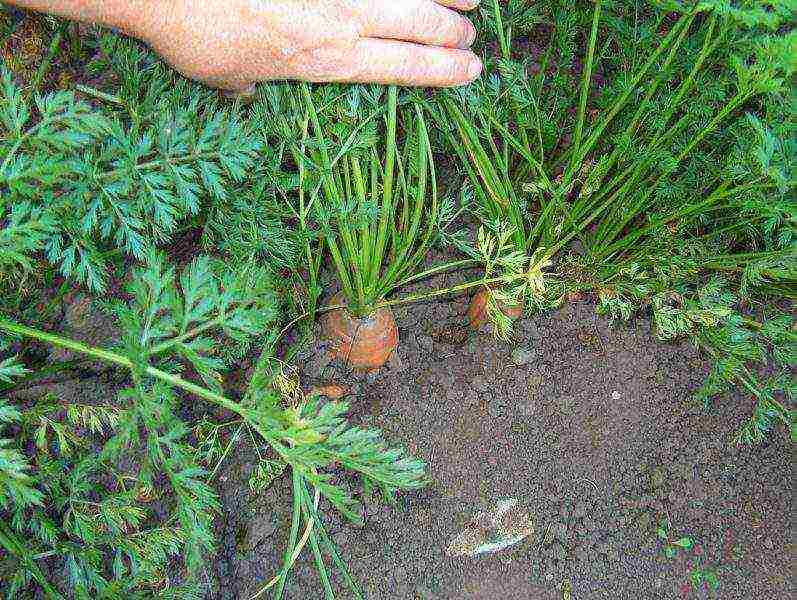
To avoid their development, you must:
- to carry out pre-sowing seed treatment, in which pathogens are destroyed;
- limit the introduction of nitrogen fertilizers that stimulate the development of gray and white rot during storage;
- do not feed the carrots with manure that provokes the development of red rot.
Of the pests on the representative of the umbrella, carrot fly, winter scoop, wireworm and slugs are noted, which must be dealt with:
- mechanically - in the case of gastropods;
- chemical method.
Carrot fly is hygrophilous, so it is better to sow in open beds, away from water bodies. Chamomile infusions scare her away.
Harvesting and storage of crops
Harvesting is carried out in several stages:
- During the second half of summer, roots are pulled out for food, and early and mid-season varieties are harvested.
- At the end of September, the harvesting of late varieties intended for long-term storage is carried out.

Root crops are harvested on a dry, warm day according to the following scheme:
- Carrots are pulled out of light soil by their tops or dug out with a pitchfork in case of heavy soils.
- The extracted vegetables are sorted.
- In healthy root crops, the tops are trimmed, after which they are placed under a canopy.
- After a few days, the crop is sent for storage.
For storage, boxes are used that are lowered into the basement or cellar, where root crops in containers are sprinkled with sand or sawdust.
The nuances of growing in the Moscow region, in Siberia
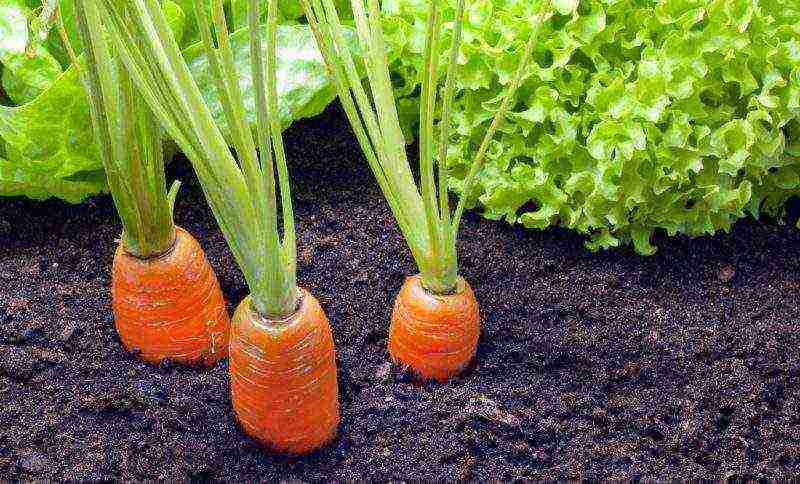
Two main parameters depend on the climatic zone of crop cultivation:
- the timing of sowing seeds in open ground;
- variety selection.
In the Moscow region, varieties of different ripening periods are grown, and seeds are sown from the second half of April to the end of spring, while for Siberia with a colder climate, the range of varieties is rather limited and comes down to several mid-season ones - for example, "Nantskaya", "Vitaminnaya". The rest of the cultivation technique for carrots is no different.
So, knowing the nuances of growing carrots, even a novice gardener will be able to achieve high rates when harvesting a vitamin vegetable.
In each region of Russia, carrots are planted at a certain time, the choice of which depends on climatic conditions. To enjoy a sweet and juicy root vegetable from your site in the Moscow region, you need to correctly determine the planting time and choose a variety.
Dates of planting carrots in the suburbs
Carrots are an unpretentious root crop, but to get a rich harvest in the Moscow region, you need to know when to plant them.
It is necessary to think about planting after the last severe frosts. The culture tolerates a drop in temperature and small frosts up to -20C.
The time of planting seeds in the soil depends on the variety of the crop and the purpose of growing. Late varieties of carrots in the Moscow region need to be planted starting in the second half of April, as they germinate for a long time. From the moment the seeds are planted in the ground until the first shoots appear, it takes about three weeks. It takes 125-145 days for late-ripening carrots to ripen. When planting a root crop in April, cover the bed with a film at night so that it rises faster.
Usually summer residents in the Moscow region sow carrots on May holidays. During this period, frosts will finally pass, and the temperature at night does not drop below + 7 ° C. But in order to enjoy the young root crop at the end of June, farmers begin to plant its early varieties in mid-April.
Mid-season varieties are versatile, they are good fresh and can be stored for a long time. They are usually planted in early May, and those intended for storage 10-15 days later.
To understand when to sow carrots, some gardeners are guided by the lunar sowing calendar for the Moscow region.
Advice! In the Moscow region, it is not advisable to plant a root crop until April 20, as there may be severe frosts.
The best varieties
The central region of Russia is characterized by variable weather and marginal land. To get a plentiful and tasty harvest in such conditions, you need to competently approach the choice of a variety.
For the Moscow region, varieties are chosen that have high fertility and frost resistance. Let's describe the most suitable ones.
Autumn queen
Late ripening carrots with high yields. She is not afraid of the cold and can be stored for a long time. The vegetable is small, juicy and sweet. The growing season is 120-130 days.
Abaco f1
Medium early root crop, perfect for winter harvesting and storage. It easily tolerates frost and gives a bountiful harvest. The shape is conical and smooth. Resistant to many diseases and cracking. From the appearance of the first shoots to ripening, an average of 110 days pass.
Beauty maiden
Medium early variety with a high concentration of carotene in vegetables. Produces a rich harvest and is resistant to cracking. The root crop is juicy, conical in shape, stands out in bright orange color. The crop can be obtained 130 days after planting.
Moscow winter
Mid-season vegetable, resistant to blooming and cold weather. It takes 2-3 months from the first shoots to ripening. The shape is elongated and obtuse, the surface is smooth with an orange color. Retains its properties during long-term storage and is suitable for winter harvesting.
Saturno f1
An early maturing variety that ripens two months after the seed has germinated. Having planted it in mid-April under a film, in late June or early July, you can get the first harvest. Differs in a high content of sugar and carotene in carrots. It has a dark orange color and is resistant to cracking.
Other noteworthy carrots include Nantes, Chantanne, Vitamin 6 and Callisto. Knowing which carrots are recommended to be planted by experts in the Moscow region, you can get a stable harvest without any problems.
Carrot sowing process
After choosing the planting time and variety, you need to properly prepare the seeds and place for the garden.
The choice of the garden
Carrots cannot grow in shaded areas. Therefore, the place for the garden should be well lit. The preparation of the soil is carried out in the fall, the site is dug up and weeds and roots are removed. Before planting a vegetable, the soil is loosened and peat, river sand or ash are added to it.
It is recommended to plant the vegetable in areas where cucumbers, onions, cabbage, tomatoes and legumes grew. If parsley, celery, dill or zucchini were grown in the garden before carrots, it will not be possible to harvest a good harvest.
Important! You cannot plant a root crop every year in the same place. The soil is depleted and even the best varieties can grow poorly.
Processing and planting seeds
An important stage of planting is the preparation of seed material. Since they germinate slowly, they are treated with a weak solution of manganese and soaked in water for 24 hours. The bad seeds will float, and the good ones will stay at the bottom. After sorting, they are dried on paper until they are free-flowing.
To make seeds easier to plant, experienced gardeners use the following methods:
- They are mixed in equal proportions with sand. Beforehand, it is thoroughly washed and dried.
- A mixture is made from carrot seeds and any early crop (lettuce, radish). They sprout quickly and make room for the growing root crop.
- Germinate seeds. They are poured into a bag and placed in moist soil for 1-2 weeks.
- Plant carrots on a ribbon. To do this, using homemade paste, the seeds are glued onto toilet paper.
Seed material is laid in prepared moist grooves up to 2 cm deep. The spacing between rows should vary within 15-20 cm. The seed is covered with soil and the beds are covered with foil. It retains moisture and creates a greenhouse effect. After emergence, it is harvested.
Care features
In order for carrots to grow well, be tasty and juicy, they need to be provided with competent care, namely:
- Watering. It should be regular and abundant. Do not allow the soil to dry out.Irrigate the plant every 3-5 days, depending on weather conditions.
- Thinning and weeding. After emergence and strengthening of seedlings, weeds and excess carrot sprouts should be removed. It is necessary to thin out the carrots twice. Leave 3-4 cm of free space between young plants. And when they grow up - at least 6 cm.
- Top dressing. In total, the carrots need to be fed twice. For the first time a month after the first shoots appear. The second is after thinning. Potash and complex fertilizers are perfect for this.
In addition, it is periodically recommended to loosen the beds. This will help break up the soil crust and oxygenate the soil.
Conclusion
If residents of the Moscow region follow simple rules and recommendations for growing carrots, they will receive a rich and high-quality harvest. They will be able to please themselves and loved ones with delicious and juicy carrots grown by their own hands.

